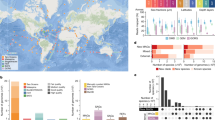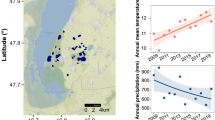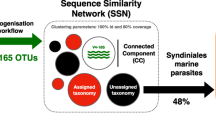Abstract
Protists (unicellular eukaryotes) arguably account for most eukaryotic diversity and are central players of the biosphere. Known protist diversity and biology is largely based on cultured strains. Yet, environmental molecular surveys have unveiled entirely novel lineages that, as their prokaryotic counterparts, are essentially uncultured. Culture bias is an important drawback for any microbe-related science and is particularly severe for heterotrophic protists, which depend on organic food sources for growth. Here, we show how ecologically significant bacterivorous protists have been brought into culture by mimicking in situ conditions. Single cells sorted by serial dilution or flow cytometry were inoculated into seawater amended with natural bacterial assemblage at nearly in situ abundances. Strains belonging to lineages only known so far from environmental sequencing were isolated. Among them, Minorisa minuta gen. nov. sp. nov. forms a novel branch within Rhizaria, holding a key evolutionary position, and with an average size of 1.4 μm represents one of the smallest bacterial grazers known to date. It has a worldwide planktonic distribution and can account for 5% of heterotrophic protists communities in coastal waters. Physiological features of this strain can partly explain its success in the environment. Culturing ecologically relevant but elusive protists provide invaluable material for ecophysiology, genomics, ecosystem modeling and evolutionary issues.
Similar content being viewed by others
Log in or create a free account to read this content
Gain free access to this article, as well as selected content from this journal and more on nature.com
or
Accession codes
References
Amann RI, Zarda B, Stahl DA, Schleifer KH . (1992). Identification of individual prokaryotic cells by using enzyme-labeled, rRNA-targeted oligonucleotide probes. Appl Environ Microbiol 58: 3007–3011.
Amann RI, Ludwig W, Schleifer KH . (1995). Phylogenetic identification and in situ detection of individual microbial cells without cultivation. Microbiol Rev 59: 143–169.
Arndt H, Dietrich D, Auer B, Cleven EJ, Gräfenhan T, Weitere M et al (2000). Functional diversity of heterotrophic flagellates in aquatic ecosystems. In: Leadbeater BSC, Green JC, (eds). The Flagellates: Unity, Diversity and Evolution. Taylor & Francis Group: London, UK, pp 240–268.
Boenigk J, Jost S, Stoeck T, Garstecki T . (2007). Differential thermal adaptation of clonal strains of a protist morphospecies originating from different climatic zones. Environ Microbiol 9: 593–602.
Button DK, Schut F, Quang P, Martin R, Robertson BR . (1993). Viability and isolation of marine bacteria by dilution culture: theory, procedures and initial results. Appl Environ Microbiol 59: 881–891.
Caron DA, Davis PG, Sieburth JMcN . (1989). Factors responsible for the differences in cultural estimates and direct microscopical counts of populations of bacterivorous microflagellates. Microb Ecol 18: 89–104.
Caron DA, Worden AZ, Countway PD, Demir E, Heidelberg KB . (2009). Protists are microbes too: a perspective. ISME J 3: 4–12.
Castresana J . (2000). Selection of conserved blocks from multiple alignments for their use in phylogenetic analysis. Mol Biol Evol 17: 540–552.
Cavalier-Smith T, Chao EEY . (2003). Phylogeny and classification of phylum cercozoa (Protozoa). Protist 154: 341–358.
Cavalier-Smith T, Chao EEY . (2006). Phylogeny and megasystematics of phagotrophic heterokonts (Kingdom Chromista). J Mol Evol 62: 388–420.
del Campo J, Massana R . (2011). Emerging diversity within chrysophytes, choanoflagellates and bicosoecids based on molecular surveys. Protist 162: 435–448.
Delwiche C . (1999). Tracing the thread of plastid diversity through the tapestry of life. Am Nat 154: S164–S177.
Díez B, Pedrós-Alió C, Massana R . (2001). Study of genetic diversity of eukaryotic picoplankton in different oceanic regions by small-subunit rRNA gene cloning and sequencing. Appl Environ Microbiol 67: 2932–2941.
Eccleston-Parry JD, Leadbeater BSC . (1994). A comparison of the growth kinetics of six marine heterotrophic nanoflagellates fed with one bacterial species. Mar Ecol Prog Ser 105: 167–177.
Epstein S, López-García P . (2008). “Missing” protists: a molecular prospective. Biodivers Conserv 8: 27–42.
Falkowski PG, Fenchel T, Delong EF . (2008). The microbial engines that drive Earth's biogeochemical cycles. Science 320: 1034–1039.
Frost BW . (1972). Effects of size and concentration of food particles on the feeding behavior of the marine planktonic copepod Calanus pacificus. Limnol Oceanogr 17: 805–815.
Gachon CMM, Day JG, Campbell CN, Pröschold T, Saxon RJ, Küpper FC . (2007). The Culture Collection of Algae and Protozoa (CCAP): a biological resource for protistan genomics. Gene 406: 51–57.
Galtier N, Gouy M, Gautier C . (1996). SEAVIEW and PHYLO_WIN: two graphic tools for sequence alignment and molecular phylogeny. Comput Appl Biosci 12: 543–548.
Garcés E, Fernandez M, Penna A, Van Lenning K, Gutierrez A, Camp J . (2006). Characterization of NW Mediterranean Karlodinium spp. (Dinophyceae) strains using morphological, molecular, chemical, and physiological methodologies. J Phycol 42: 1096–1112.
Giovannoni SJ, Foster RA, Rappé MS, Epstein S . (2007). New cultivation strategies bring more microbial plankton species into the laboratory. Oceanography 20: 62–69.
Giovannoni SJ, Stingl U . (2007). The importance of culturing bacterioplankton in the ‘omics’ age. Nature Rev Microbiol 5: 820–826.
Guillou L, Chrétiennot-Dinet MJ, Boulben S, Moon-van der Staay SY, Vaulot D . (1999). Symbiomonas scintillans gen. et sp. nov. and Picophagus flagellatus gen. et sp. nov. (Heterokonta): two new heterotrophic flagellates of picoplanktonic size. Protist 150: 383–398.
Heywood JL, Sieracki ME, Bellows W, Poulton NJ, Stepanauskas R . (2011). Capturing diversity of marine heterotrophic protists: one cell at a time. ISME J 5: 674–684.
Huelsenbeck JP, Ronquist F . (2001). MrBayes: Bayesian inference of phylogenetic trees. Bioinfomatics 17: 754–755.
Jürgens K, Massana R . (2008). Protistan grazing on marine bacterioplankton. In: Kirchman DL, (ed.) Microbial Ecology of the Oceans, 2nd Edition John Wiley & Sons, Inc.: New York, USA, pp 383–441.
Katoh K, Misawa K, Kuma K, Miyata T . (2002). MAFFT: a novel method for rapid multiple sequence alignment based on fast Fourier transform. Nucleic Acids Res 30: 3059–3066.
Könneke M, Bernhard AE, de la Torre JR, Walker CB, Waterbury JB, Stahl DA . (2005). Isolation of an autotrophic ammonia-oxidizing marine archaeon. Nature 437: 543–546.
Lim EL, Dennet MR, Caron DA . (1999). The ecology of Paraphysomonas imperforata based on studies employing oligonucleotide probe identification in coastal water samples ans enrichment cultures. Limnol Oceanogr 44: 37–51.
Ludwig W, Strunk O, Westram R, Richter L, Meier H, Yadhukumar et al (2004). ARB: a software environment for sequence data. Nucleic Acids Res 32: 1363–1671.
Marie D, Shi XL, Rigaut-Jalabert F, Vaulot D . (2010). Use of flow cytometric sorting to better assess the diversity of small photosynthetic eukaryotes in the English Channel. FEMS Microbiol Ecol 72: 165–178.
Massana R, Balagué V, Guillou L, Pedrós-Alió C . (2004). Picoeukaryotic diversity in an oligotrophic coastal site studied by molecular and culturing approaches. FEMS Microbiol Ecol 50: 231–243.
Massana R, Terrado R, Forn I, Lovejoy C, Pedrós-Alió C . (2006a). Distribution and abundance of uncultured heterotrophic flagellates in the world oceans. Environ Microbiol 8: 1515–1522.
Massana R, Guillou L, Terrado R, Forn I, Pedrós-Alió C . (2006b). Growth of uncultured heterotrophic flagellates in unamended seawater incubations. Aquat Microb Ecol 45: 171–180.
Montagnes D, Roberts E, Lukeš J, Lowe C . (2012). The rise of model protozoa. Trends Microbiol 20: 184–191.
Not F, Simon N, Biegala IC, Vaulot D . (2002). Application of fluorescent in situ hybridization coupled with tyramide signal amplification (FISH-TSA) to assess eukaryotic picoplankton composition. Aquat Microb Ecol 28: 157–166.
Not F, Gausling R, Azam F, Heidelberg JF, Worden AZ . (2007). Vertical distribution of picoeukaryotic diversity in the Sargasso Sea. Environ Microbiol 9: 1233–1252.
Pedrós-Alió C . (2006). Marine microbial diversity: can it be determined? Trends Microbiol 14: 257–263.
Pernthaler A, Pernthaler J, Amann R . (2004). Sensitive multicolor fluorescence in situ hybridization for the identification of environmental microorganisms. In: Akkermans ADL, de Bruijn FJ, van Elsas JD, (eds). Molecular Microbial Ecology Manual 2nd Edition Kluwer Academic Publishers: Dordrecht, Netherlands, pp 711–726.
Pernthaler J . (2005). Predation on prokaryotes in the water column and its ecological implications. Nature Rev Microbiol 3: 537–546.
Porter KG, Feig YS . (1980). The use of DAPI for identifying and counting aquatic microflora. Limnol Oceanogr 25: 943–948.
Raes J, Bork P . (2008). Molecular eco-systems biology: towards an understanding of community function. Nature Rev Microbiol 6: 683–699.
Rappé MS, Connon SA, Vergin KL, Giovannoni SJ . (2002). Cultivation of the ubiquitous SAR11 marine bacterioplankton clade. Nature 418: 630–633.
Rogers MB, Gilson PR, Su V, McFadden GI, Keeling PJ . (2007). The complete chloroplast genome of the chlorarachniophyte Bigelowiella natans: evidence for independent origins of chlorarachniophyte and euglenid secondary endosymbionts. Mol Biol Evol 24: 54–62.
Rose JM, Caron DA, Sieracki ME, Poulton NJ . (2004). Counting heterotrophic nanoplanktonic protists in cultures and aquatic communities by flow cytometry. Aquat Microb Ecol 34: 263–277.
Sherr EB, Sherr BF . (2002). Significance of predation by protists in aquatic microbial food webs. Anton van Leeuwen 81: 293–308.
Sherr BF, Sherr EB, Caron DA, Vaulot D . (2007). Oceanic protists. Oceanography 20: 130–134.
Stamatakis A . (2006). RAxML-VI-HPC: maximum likelihood-based phylogenetic analyses with thousands of taxa and mixed models. Bioinformatics 22: 2688–2690.
Tripp HJ, Kitner JB, Schwalbach MS, Dacey JWH, Wilhelm LJ, Giovannoni SJ . (2008). SAR11 marine bacteria require exogenous reduced sulphur for growth. Nature 452: 741–744.
Urdea MS, Warner BD, Running JA, Stempien M, Clyne J, Horn T . (1988). A comparison of non-radioisotopic hybridization assay methods using fluorescent, chemiluminescent, and enzyme labeled oligodeoxyribonucleotide probes. Nucleic Acids Res 16: 4937–4956.
Vaulot D, Romari K, Not F . (2002). Are autotrophs less diverse than heterotrophs in marine picoplankton? Trends Microbiol 10: 266–267.
Vaulot D, Eikrem W, Viprey M, Moreau H . (2008). The diversity of small eukaryotic phytoplankton (⩽ 3 μm) in marine ecosystems. FEMS Microbiol Ecol 32: 795–820.
Worden AZ, Lee JH, Mock T, Rouzé P, Simmons MP, Aerts AL et al (2009). Green evolution and dynamic adaptations revealed by genomes of the marine picoeukaryotes. Micromonas. Science 324: 268–272.
Acknowledgements
This study was supported by projects MICROVIS (CTM2007–62140/MAR, MEC), FLAME (CGL2010–16304, MICINN) and BioMarKs (2008–6530, ERA-net Biodiversa, EU). JdC was funded by the I3P program (I3PPRE-06–00676, CSIC) and FN by the Marie-Curie fellowship ESUMAST (MEIF-CT-2005–025000). We thank Marco Álvarez for help in TSA-FISH, Vanessa Balagué for help in molecular analysis, José Manuel Fortuño for help in SEM and Nicole Poulton for help in flow cytometry.
Author information
Authors and Affiliations
Corresponding author
Additional information
Supplementary Information accompanies the paper on The ISME Journal website
Rights and permissions
About this article
Cite this article
del Campo, J., Not, F., Forn, I. et al. Taming the smallest predators of the oceans. ISME J 7, 351–358 (2013). https://doi.org/10.1038/ismej.2012.85
Received:
Revised:
Accepted:
Published:
Issue date:
DOI: https://doi.org/10.1038/ismej.2012.85
Keywords
This article is cited by
-
Single cell genomics yields a wide diversity of small planktonic protists across major ocean ecosystems
Scientific Reports (2019)
-
Plastid phylogenomics with broad taxon sampling further elucidates the distinct evolutionary origins and timing of secondary green plastids
Scientific Reports (2018)
-
Kingdom Chromista and its eight phyla: a new synthesis emphasising periplastid protein targeting, cytoskeletal and periplastid evolution, and ancient divergences
Protoplasma (2018)
-
Exploring the uncultured microeukaryote majority in the oceans: reevaluation of ribogroups within stramenopiles
The ISME Journal (2014)
-
Culturing Bias in Marine Heterotrophic Flagellates Analyzed Through Seawater Enrichment Incubations
Microbial Ecology (2013)



